Navigation
The Commercialization of Camels in Mid-altitude Ethiopia and Beyond
A recently published report, Shifting Sands: The Commercialization of Camels in Mid-altitude Ethiopia and Beyond, describes a relatively new trend in pastoralist livestock marketing that is a dynamic response to increasing demand for camels in mid-altitude areas of Ethiopia and in neighboring Sudan.
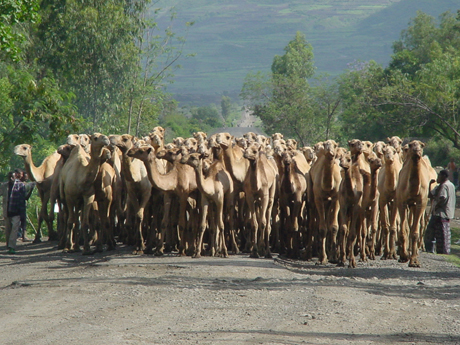 |
| The recurrence of drought and its immediate impact on other livestock species – cattle, donkeys and mules – has been attributed by nearly all farmers and traders to the increasing shift in the preference of camels. |
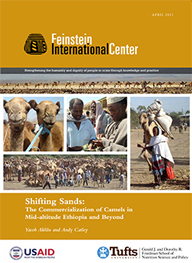 |
A recently published report, Shifting Sands: The Commercialization of Camels in Mid-altitude Ethiopia and Beyond, describes a relatively new trend in pastoralist livestock marketing that is a dynamic response to increasing demand for camels in mid-altitude areas of Ethiopia and in neighboring Sudan. The report was published by in April 2011 by the Feinstein International Center, Tufts University.
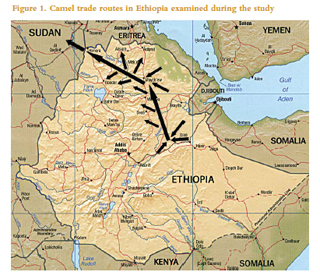 |
| Camel trade routes in Ethiopia examined during the study. |
In response to that demand, a camel trade network has evolved that covers about 2000 km, involves more than six ethnic groups, and is served by 24 markets.
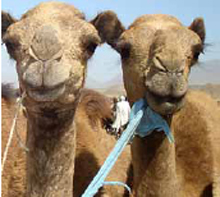 |
| The rising domestic demand for camels coupled with growing export opportunities to Sudan and Egypt should be viewed as an opportunity for poverty alleviation for those who are involved in raising camels and trade. In this regard, the economic importance of camels need not be measured from the narrow scope of foreign exchange revenue generation alone. Providing appropriate support for the sector has to begin by extending the due recognition farmers deserve for caring and nurturing a species that has been inadvertently ignored by policy makers for so long. |
The bulk of Ethiopia’s growing formal and informal livestock and meat exports are supplied from pastoralist areas of the country.
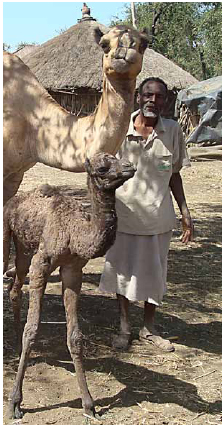 |
| Yimer Ibrahim with one of his newly born camels in the mid-altitude location of Selen Wuha, Alamata. |
The rising demand for camels by mid-altitude farmers in Ethiopia is associated with the drought-tolerant nature of camels and their multiple uses as pack animals.
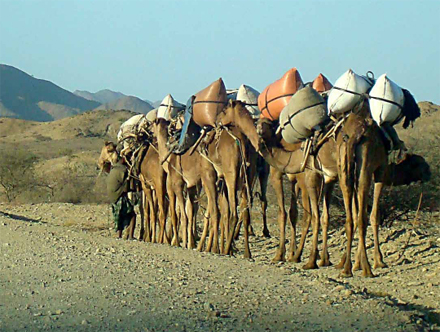 |
| Camels are not only drought-tolerant; they do not require grazing on pasture, which is increasingly lacking. Camels survive and flourish by browsing on available browses and shrubs. |
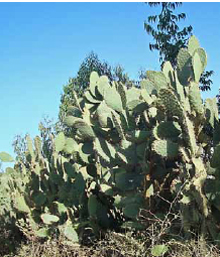 |
| The commoonly seen spiny cactus is browsed by camels. |
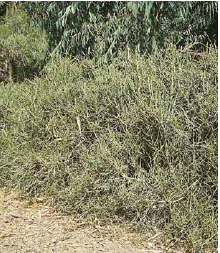 |
| Euphorbia tirucalli is a common food for camels in mid-altitude areas. |
Emerging in the absence of aid or government programs, the camel trade shows how economic synergies between pastoralist and non-pastoralist areas can develop and provides further evidence of the market responsiveness of pastoralists, even when faced by drought and other constraints.
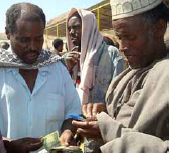 |
| A camel buyer and guarantor at Chifra market, Afar Region. In nearly all the markets each seller is required to produce a guarantor to prove that the camel or camels he is selling actually belongs to him. |
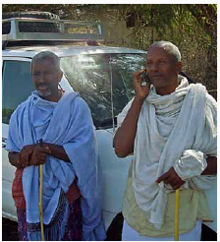 |
| Mobile phones are important for medium-level camel traders. |
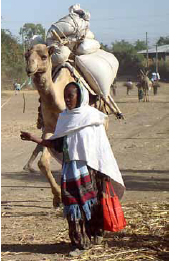 |
| Woman with camel. |
"Shifting Sands: The Commercialization of Camels in Mid-altitude Ethiopia and Beyond," written by Yacob Aklilu and Andy Catley, was published in April 2011 by by the Feinstein International Center, Tufts University.
The report is available at http://fic.tufts.edu.
Photographs are by Yacob Aklilu. Captions are excerpted from the report.
 |
Search
Latest articles
Agriculture
- World Water Week: Healthy ecosystems essential to human health: from coronavirus to malnutrition Online session Wednesday 24 August 17:00-18:20
- World Water Week: Healthy ecosystems essential to human health: from coronavirus to malnutrition Online session Wednesday 24 August 17:00-18:20
Air Pollution
- "Water and Sanitation-Related Diseases and the Changing Environment: Challenges, Interventions, and Preventive Measures" Volume 2 Is Now Available
- Global Innovation Exchange Co-Created by Horizon International, USAID, Bill and Melinda Gates Foundation and Others
Biodiversity
- It is time for international mobilization against climate change
- World Water Week: Healthy ecosystems essential to human health: from coronavirus to malnutrition Online session Wednesday 24 August 17:00-18:20
Desertification
- World Water Week: Healthy ecosystems essential to human health: from coronavirus to malnutrition Online session Wednesday 24 August 17:00-18:20
- UN Food Systems Summit Receives Over 1,200 Ideas to Help Meet Sustainable Development Goals
Endangered Species
- Mangrove Action Project Collaborates to Restore and Preserve Mangrove Ecosystems
- Coral Research in Palau offers a “Glimmer of Hope”
Energy
- Global Innovation Exchange Co-Created by Horizon International, USAID, Bill and Melinda Gates Foundation and Others
- Wildlife Preservation in Southeast Nova Scotia
Exhibits
- Global Innovation Exchange Co-Created by Horizon International, USAID, Bill and Melinda Gates Foundation and Others
- Coral Reefs
Forests
- NASA Satellites Reveal Major Shifts in Global Freshwater Updated June 2020
- Global Innovation Exchange Co-Created by Horizon International, USAID, Bill and Melinda Gates Foundation and Others
Global Climate Change
- It is time for international mobilization against climate change
- It is time for international mobilization against climate change
Global Health
- World Water Week: Healthy ecosystems essential to human health: from coronavirus to malnutrition Online session Wednesday 24 August 17:00-18:20
- More than 400 schoolgirls, family and teachers rescued from Afghanistan by small coalition
Industry
- "Water and Sanitation-Related Diseases and the Changing Environment: Challenges, Interventions, and Preventive Measures" Volume 2 Is Now Available
- Global Innovation Exchange Co-Created by Horizon International, USAID, Bill and Melinda Gates Foundation and Others
Natural Disaster Relief
- STOP ATTACKS ON HEALTH CARE IN UKRAINE
- Global Innovation Exchange Co-Created by Horizon International, USAID, Bill and Melinda Gates Foundation and Others
News and Special Reports
- World Water Week: Healthy ecosystems essential to human health: from coronavirus to malnutrition Online session Wednesday 24 August 17:00-18:20
- STOP ATTACKS ON HEALTH CARE IN UKRAINE
Oceans, Coral Reefs
- World Water Week: Healthy ecosystems essential to human health: from coronavirus to malnutrition Online session Wednesday 24 August 17:00-18:20
- Mangrove Action Project Collaborates to Restore and Preserve Mangrove Ecosystems
Pollution
- Zakaria Ouedraogo of Burkina Faso Produces Film “Nzoue Fiyen: Water Not Drinkable”
- "Water and Sanitation-Related Diseases and the Changing Environment: Challenges, Interventions, and Preventive Measures" Volume 2 Is Now Available
Population
- "Water and Sanitation-Related Diseases and the Changing Environment: Challenges, Interventions, and Preventive Measures" Volume 2 Is Now Available
- "Water and Sanitation-Related Diseases and the Changing Environment: Challenges, Interventions, and Preventive Measures" Volume 2 Is Now Available
Public Health
- Honouring the visionary behind India’s sanitation revolution
- Honouring the visionary behind India’s sanitation revolution
Rivers
- World Water Week: Healthy ecosystems essential to human health: from coronavirus to malnutrition Online session Wednesday 24 August 17:00-18:20
- Mangrove Action Project Collaborates to Restore and Preserve Mangrove Ecosystems
Sanitation
- Honouring the visionary behind India’s sanitation revolution
- Honouring the visionary behind India’s sanitation revolution
Toxic Chemicals
- "Water and Sanitation-Related Diseases and the Changing Environment: Challenges, Interventions, and Preventive Measures" Volume 2 Is Now Available
- Actions to Prevent Polluted Drinking Water in the United States
Transportation
- "Water and Sanitation-Related Diseases and the Changing Environment: Challenges, Interventions, and Preventive Measures" Volume 2 Is Now Available
- Urbanization Provides Opportunities for Transition to a Green Economy, Says New Report
Waste Management
- Honouring the visionary behind India’s sanitation revolution
- Honouring the visionary behind India’s sanitation revolution
Water
- Honouring the visionary behind India’s sanitation revolution
- Honouring the visionary behind India’s sanitation revolution
Water and Sanitation
- Honouring the visionary behind India’s sanitation revolution
- Honouring the visionary behind India’s sanitation revolution

